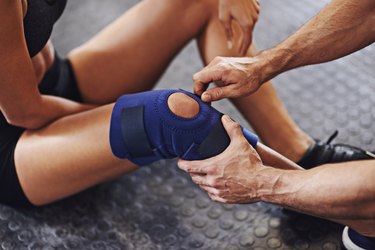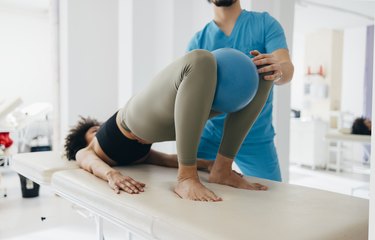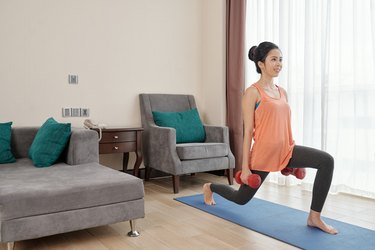
You rely on your knees to support your movements during a workout. When you experience knee pain after a workout, you may be concerned that an underlying condition exists.
Understanding why you experience knee pain after you exercise can be a matter of evaluating the types of exercises you are performing and the location of your pain. Learning when you can continue exercising with knee pain — and when you cannot — is important to your continued good health.
Video of the Day
Video of the Day
Tip
High-impact exercise, such as running, can lead to knee soreness after workouts.
Knee Pain After Exercise
If you experience knee pain after exercising, take immediate steps to reduce inflammation. This includes icing your knee within 10 to 20 minutes after your workout. You also may wish to take an anti-inflammatory medication such as ibuprofen, if approved by your doctor.
Evaluate your footwear as well. Lack of support, particularly arch support, often contributes to knee pain. Your physician or a shoe specialist can evaluate your shoes to ensure they are in good enough shape to continue exercising.
If your knees continue to swell or the pain gets worse instead of better, you may need to take a few days from exercising and seek medical attention.
High-Impact Exercises
Your knees are the major shock absorbers of your body, absorbing the impact each time you take a step. If you participate in high-impact activities, like running, volleyball or basketball, you are at increased risk for experiencing knee pain after working out.
If you experience pain in both knees after high-impact exercise, this may be a sign you need to alternate high- and low-impact activities. These include activities like exercising on an elliptical machine or swimming, which puts less strain on your knees. Incorporating these activities into your workout routine may help to take the pressure off your knees.
Incorporate Strengthening Exercises
If a physician has evaluated your knee and determined you have not experienced a serious injury, you may wish to engage in some knee-strengthening exercises to reduce pain and restore stability to your knee.
Examples of exercises include sitting with your legs extended and slowly lifting your leg about 6 to 8 inches off the floor. Repeat five to 10 times on each leg. From a seated position with your legs extended, you also can cross one leg over the other to stretch the outer portion of the knee. Hold for five seconds; then release the stretch and repeat on the opposite side.
Your physician may also recommend alternate stretches to help with sore knees after working out.
Injuries and Knee Pain
There are a number of bones, tendons and muscles related to the knee, providing ample opportunity for injuries that can cause knee pain after a workout. You may experience conditions like runner's knee, which causes pain behind the kneecap, and iliotibial band syndrome, which causes pain outside the knee.
Both injury and overuse can cause you to experience knee pain. If your knee pain does not subside with rest, see your physician, who can evaluate your knee for potential injury. Knee pain does not always mean surgery — your physician can recommend several conservative approaches to treat pain.
Is this an emergency? If you are experiencing serious medical symptoms, please see the National Library of Medicine’s list of signs you need emergency medical attention or call 911.


